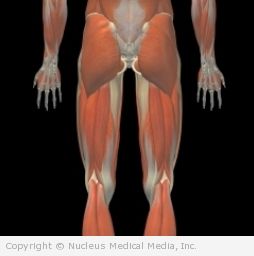Hamstrings strain
(Pulled Hamstrings)
Hamstrings strain – Definition
A hamstring strain is a partial tear of the small fibers of the muscles in the hamstring group. The hamstrings are the large group of muscles in the back of the thigh. They consist of three muscles that run from above the hip to below the knee joint.
Hamstrings strain – Causes
A hamstring strain can be caused by:
- Stretching the hamstrings beyond the amount of tension that they can withstand
- Suddenly putting stress on the hamstrings when they are not ready for the stress
- Using the hamstrings too much on a certain day
- Having a direct blow to the hamstrings
- Hamstring strain is a common sports-related injury.
Hamstrings strain – Risk Factors
A risk factor is something that increases your chance of getting an injury. Risk factors for a hamstring strain include:
- Participation in sports that require bursts of speed, such as:
- Running
- Hurdles
- Long jump
- Basketball
- Soccer
- Football
- Rugby
- Fatigue
- Tight hamstrings
- Overexertion
- Cold weather
- Previous hamstring injury
Hamstrings strain – Symptoms
Symptoms include:
- Pain and tenderness in the back of the thigh
- Stiffness in the hamstrings
- Weakness in the hamstrings
- Bruising on the back of the thigh, if blood vessels are broken
- Popping or snapping sensation as the muscle tears (possibly)
Hamstrings strain – Diagnosis
The doctor will ask about your symptoms and medical history, your recent physical activity, and how the injury occurred. The doctor will also examine your thighs for:
- Tenderness and/or bruising directly over the hamstrings
- Pain and weakness when contracting the hamstrings, particularly against resistance
Muscle strains are graded according to their severity:
Grade1
- Some stretching with micro-tearing of muscle fibers
- Recovery can be complete in 10-21 days.
Grade 2
- Partial tearing of muscle fibers
- Recovery can take up to 1-2 months.
Grade 3
- Complete tearing (rupture) of muscle fibers
- Recovery can take more than three months.
- Surgery may be needed to repair the torn muscle fibers. This is very rare.
For a severe hamstring strain, you may have an MRI scan to see if the tearing requires surgical repair. Professional and collegiate athletes sometimes have MRI scans to help predict the length of their recovery.
Hamstrings strain – Treatment
Treatment depends on the severity of the strain. Your doctor may recommend that you work with a physical therapist. Treatment options include:
Rest
Do not do activities that cause pain, such as running, jumping, and weight lifting using the thigh muscles. If normal walking hurts, shorten your stride. Do not play sports until your doctor or physical therapist has given you permission to do so.
Cold
Apply ice or a cold pack to the hamstring area for 15-20 minutes, four times a day, for several days after the injury. Wrap the ice or cold pack in a towel. Do not apply the ice directly to your skin.
Pain Relief Medications
Your doctor may recommend that you take over-the-counter medicines, such as aspirin, ibuprofen, or acetaminophen, to help relieve pain. Topical pain medicines (eg, creams, patches) applied to the skin are another option.
Ask your doctor if you have any questions about using these medications. If you still have tenderness in the hamstrings while taking these drugs, do not return to physical activity. Check with your doctor before returning to activity.
Compression
Wear an elastic compression bandage (eg, Ace bandage) around your thigh to prevent additional swelling. Be careful not to wrap the bandage too tight.
Elevation
Keep your leg higher than your heart as much as possible for the first 24 hours or so to minimize swelling. A couple of days of elevation might be recommended for severe strains.
Heat
Use heat only when you are returning to physical activity. Then use it before stretching or getting ready to play sports.
Stretching
When the acute pain is gone, start gentle stretching as recommended by a healthcare professional. Stay within pain limits. Hold each stretch for about 10 seconds and repeat six times. Stretch several times a day.
Strengthening
Begin strengthening exercises for your hamstrings as recommended by a healthcare professional.
If you are diagnosed with a hamstring strain, follow your doctor’s instructions.
Hamstrings strain – Prevention
To reduce the chance that you will strain your hamstrings:
- Keep your hamstrings strong so they can absorb the energy of sudden physical stress.
- Always do a short warm-up period before stretching your hamstrings.
- Learn the proper technique for exercise and sporting activities. This will decrease stress on all your muscles, including your hamstrings.

